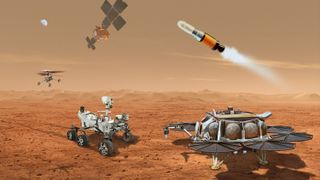Home
News
Tech

Artist’s conception of the vehicles that would participate in a Mars sample return by NASA and the European Space Agency.
(Image credit: NASA/JPL-Caltech)
NASA’s Mars Sample Return mission is facing some tough scrutiny.
The Senate Appropriations Committee offered their recommendations on the spending bill for fiscal year 2024, and they do not provide all NASA was hoping for. The Commerce, Justice and Science (CJS) spending bill, which allocates funds for NASA and a few other government agencies, was reviewed by the committee in a 28 to 1 vote on July 13. The bill secures funding for NASA’s ongoing Artemis program to the moon and other exploration initiatives, but cuts the space agency’s budget for planetary science by over half a billion dollars.
In opening remarks, Senator Patty Murray stated the bill was, “written under some very difficult limitations,” adding her stance that “those caps limit our ability to invest in our country’s future.”
First on the Committee’s chopping block seems to be NASA’s ambitious Mars Sample Return mission (MSR), a plan to retrieve Martian geological specimens collected by the Perseverance rover. The report raises concerns with the mission’s continually delayed timeline and increasing costs. A recent Ars Technica report details ballooning internal cost projections for MSR at NASA, nearly doubling the mission’s overall estimate to between $8 and $9 billion.
Related: What’s ahead in returning samples from Mars?
The Senate Committee’s report indicates their concern that MSR is taking priority over other critical path NASA missions, stating, “the Committee has significant concerns about the technical challenges facing MSR and potential further impacts on confirmed missions, even before MSR has completed preliminary design review.”
The report gives NASA 180 days following the bill’s enactment to provide a year-by-year budget break-down for MSR that fits into the $5.3 billion lifecycle cost outline included in the 2022 Planetary Science Decadal Survey. If the space agency misses the deadline, or fails to reduce costs to fit within the proposed budget, the mission could face cancelation. The Committee also took the liberty to suggest programs where those funds might be reallocated, should that cancelation take place. They include the Artemis campaign, the Dragonfly mission, and a “flagship orbiter and probe” mission to Uranus.
The decadal survey, which guides NASA’s exploration priorities over the next ten years, puts MSR at the top of its list, but according to the Senate report, “the Committee is alarmed that despite Congress providing the full request for this mission in prior years […] the expected launch schedule continues to slip and the increasing fiscal and human resources devoted to MSR is causing NASA to delay other high priority missions across the Science Mission Directorate.”

At the “Three Forks” sample depot at Jezero Crater, 10 sample tubes are seen in this photomontage of images taken by the NASA Perseverance Mars rover’s WATSON camera on the end of the robot’s mechanical arm. (Image credit: NASA/JPL-Caltech/MSSS)
MSR’s mission objective is built right into its name – collect samples from the Martian surface and return them for study back on Earth. Throughout the history of spaceflight, only a handful of robotic lunar sample return missions have been successful. Attempting to collect and return material from Mars is an ambitious undertaking that has never been attempted.
The mission is a collaboration between NASA and the European Space Agency (ESA), which will require a robotic lander, a pair of helicopter-like drones similar to the Ingenuity helicopter hoping around the Martian surface alongside the Perseverance rover. Perseverance is also contributing to the MSR mission. The rover is equipped with 38 sample containers it is filling and depositing as it navigates Mars’s surface, which will eventually be collect by the MSR lander.
Once gathered, an ascent vehicle will launch the samples into orbit of the red planet, and rendezvous with and Earth Return Orbiter, which will rocket itself out of Mars orbit on a course for Earth, where a return capsule will bring the samples’ long journey to an end with a soft parachute-assisted landing in the Utah desert.
If successful, the recovered Martian material could provide invaluable data for researchers. Theories about Mars’s geological development, the history of the planet, even signs of ancient biological life could be derived from the haul. However, for the Senate Committee, it seems, a successful MSR isn’t worth sacrificing NASA’s other crucial missions.
The decadal survey agrees, to a point. It recommends MSR “be completed as rapidly as possible,” but stresses that the cost of the mission “should not be allowed to undermine the long-term programmatic balance of the planetary portfolio.” Rather than suggest shelving the mission if MSR goes over budget, the survey recommends NASA work with lawmakers to “secure a budget augmentation” to help guarantee its success.
Aside from MSR, the CJS spending bill increases NASA’s purse for its exploration programs from this year to next by about $270 million, however, but that still falls $230 million short of the space agency’s 2024 budget request.
On a whole, the bill actually reduces NASA’s funds by $384 million compared to fiscal year 2023. This is partially due to the Fiscal Responsibility Act, passed by the Senate last month, which caps non-defense spending for next year, and only allows a 1 percent increase going into 2025.
Join our Space Forums to keep talking space on the latest missions, night sky and more! And if you have a news tip, correction or comment, let us know at: [email protected].
Breaking space news, the latest updates on rocket launches, skywatching events and more!
Josh Dinner is a writer and photographer with a passion for science and space exploration. He began freelancing the space beat in 2016, and has covered the evolution of NASA’s commercial spaceflight partnerships, from early Dragon and Cygnus cargo missions to the ongoing crewed launches to the International Space Station, and spent much of 2022 chronicling the epic of NASA’s Artemis 1 rocket. He also enjoys building 1:144 scale models of rockets and human-flown spacecraft. Find some of Josh’s launch photography at his website and on Instagram, and follow him on Twitter, where he mostly posts in haiku.
>>> Read full article>>>
Copyright for syndicated content belongs to the linked Source : Space.com – https://www.space.com/mars-sample-return-faces-senate-committee-cancellation














![[News] Japan Develops 10nm Nanoimprint Technology, with Potential to Tackle EUV Bottleneck – TrendForce](https://earth-news.info/wp-content/uploads/2025/12/329851-news-japan-develops-10nm-nanoimprint-technology-with-potential-to-tackle-euv-bottleneck-trendforce-360x180.jpg)
















